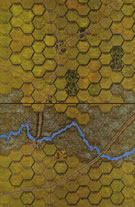| Author |
dricher
|
| Method |
Solo |
| Victor |
United States |
| Play Date |
2014-12-07 |
| Language |
English |
| Scenario |
Airb020
|
Once again, a lengthy scenario in which the Americans must capture the bridge in 0412, while this time the Germans can keep it or blow it. The counter density is high, and Germans start strung out across the length of the board while the Americans have trouble finding enough space to set up in one corner.
The Americans quickly push into the German defenses, sweeping away German positions in the northern towns as well as Germans guarding the eastern approaches. A few Germans fall back, but most are wiped out in the early turns. The Germans suffer enough steps for the Americans to declare victory, except German control of the bridge will still pull the draw. So the Americans must now drive south and take the bridge before reinforcements arrive.
This proves to be the tough part. The German defenses on the north end of the causeway hold strong, and in fact the Germans challenge control of the central town for 20 turns before finally giving way. By that time, however, the Americans have sent troops over the eastern bridge while also moving in to contest the town/bridge in 0412. The flanking forces manage to arrive just in time to interfere with reinforcements, which are slow to arrive, and throw themselves at the German tanks before they can reach the town. The carnage against the Americans is horrific, as the Germans now quickly tally steps against the Americans and can achieve their victory count as long as they hold or blow the bridge (they can attempt to blow starting turn 26).
The Americans battle hard for 0412, while the flanking forces are being eaten up while destroying German reinforcements. Hex 0412 finally falls to the Americans on turn 24, but what reinforcements are still active (Germans have lost the tanks and a Gren, and 2 Grens have not arrived, but the rest is mostly intact) attempt to storm the town. They get two hexes away before American forces can scratch up enough strength to deal with them. American Army and Airborne leaders cannot activate each other’s units, so getting a consolidated task force at this point is tough. The Army did most of the capture work, and has been significantly banged up, while the Airborne units provided support against weaker German positions and took care of flanking responsibilities. Add the Airborne exhaustion factor (may not manage to activate), and dealing with emergencies at this point is difficult. But the Americans finally jump on the reinforcements, and the assault goes the way of the Americans. The Germans, even if the two Grens finally appear, are too weak to continue the battle, and the Americans declare victory with the bridge in hand.
I give this a scenario a 4, but it is a weaker 4 than its superior cousin Second Try. The Germans should immediately pack up the 50mm and move it to 0412. Had they done so, the American tanks may have not had the opportunity to join the assault before the Germans could try to blow the bridge. The clock was already close to running out, and a couple more turns of sturdy defense could have cost the game for the Americans. What looked to be a quick victory for the Americans at the start turned into a slogging mess as they approached the bridge. Antitank capability in hex 0412 could easily have spelled doom. Overall decently balanced, and the Americans must move quick at the start while the Germans play for time.
|






 Airb019
Airb019 




































